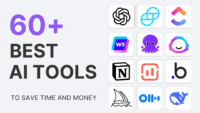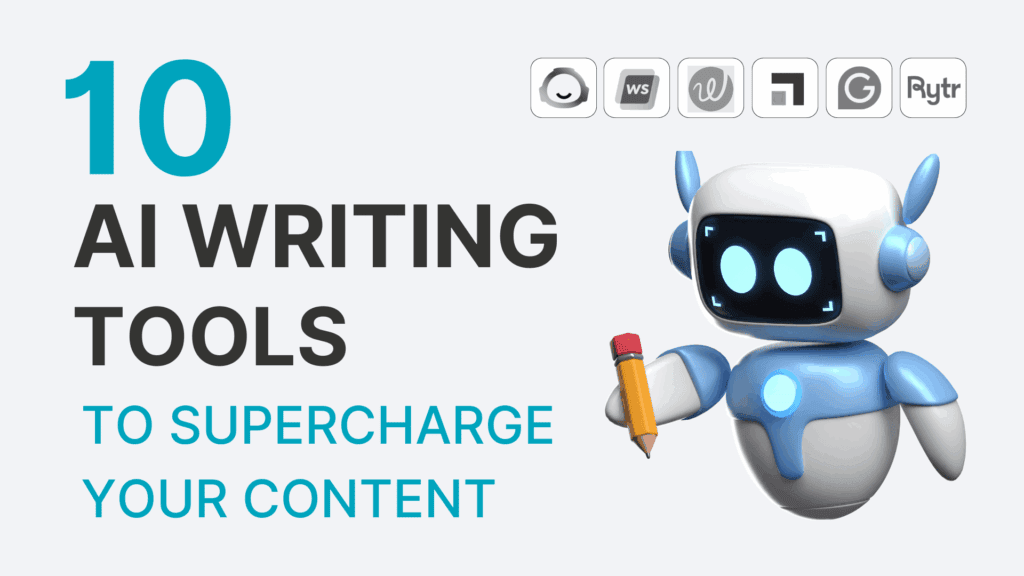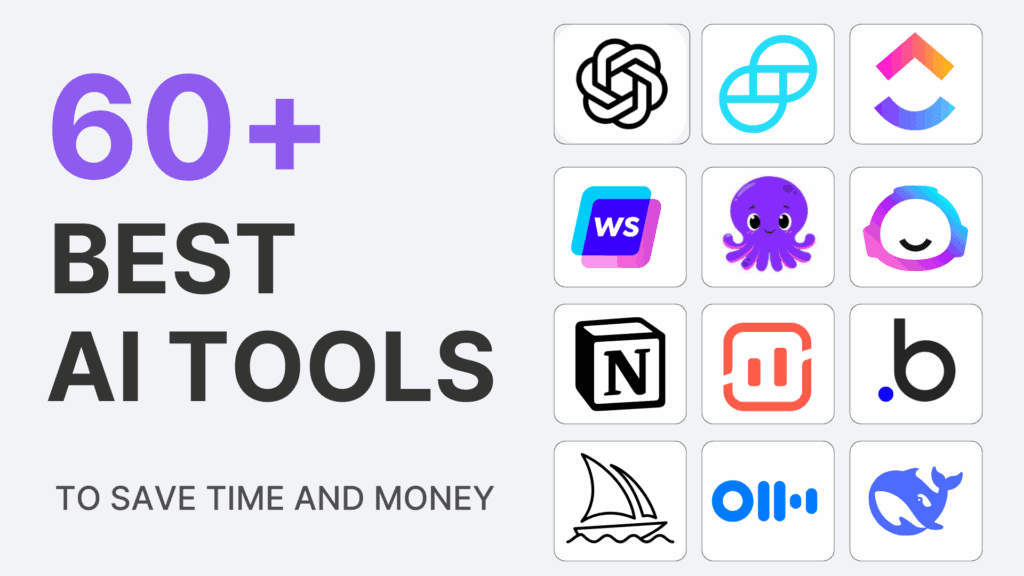When it comes to building the right portfolio of affiliate partners, affiliate program managers need to make sure these partnerships align with the goals and objectives of the brand. Not all affiliates and publishers are being created equal.
Through evergreen, exclusive, or cross-partner promotion tactics, affiliate program managers manage the full relationship cycle with affiliates such as content partners, creators, influencers, loyalty sites, or tech tool partners to amplify the merchant’s brand message across many channels and audiences.
In this article, we will review in more detail what types of affiliate partners a brand can recruit and work with. For the most part, these partners fall under four groups:
- Content Partners
- Coupon and loyalty partners
- Cross-Method partners
- Financial and tech partners
Ready? Let’s dive in!
Content Partners
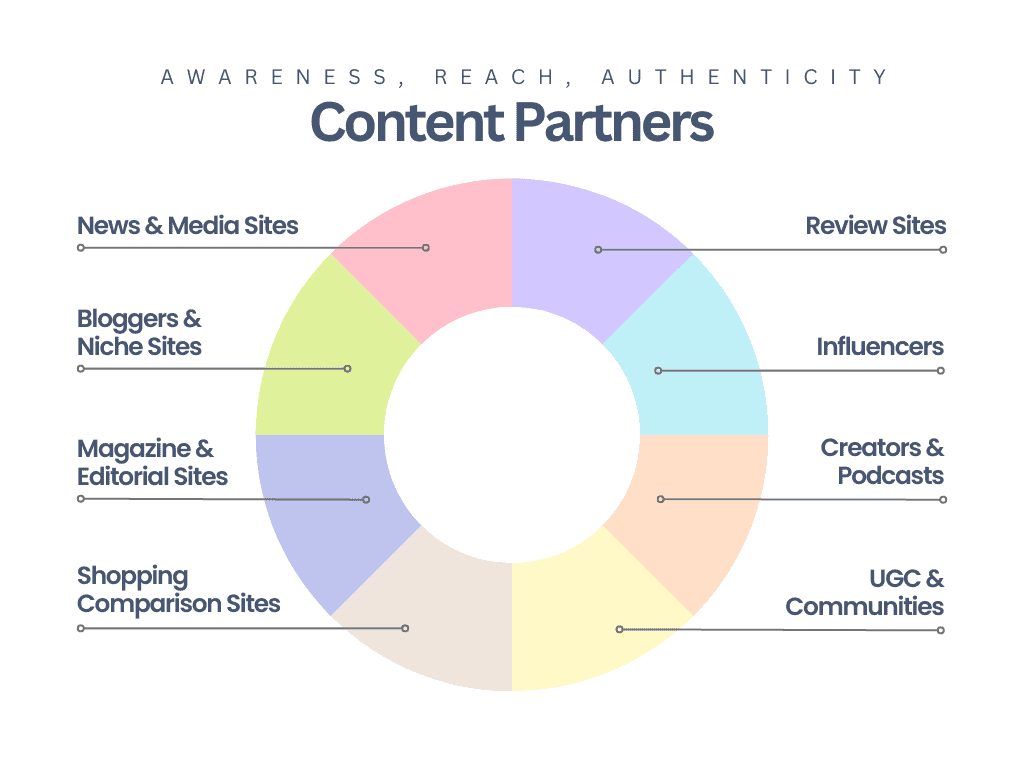
Content Sites
Content sites provide valuable information, reviews, and recommendations that drive organic traffic and conversions through quality content.
These content partnerships don’t scale quickly and may require a long-term investment but they drive the most incremental results.
Content partners are savvy, they use development tools to streamline their content processes and ensure a flawless experience for their audience. They are also set up on sub-networks like Skimlinks to consolidate reporting and work with many brands and advertisers, consolidating the management under one platform.
We will get into more details about Skimlinks in a later section.
Take the time to build a solid relationship with content partners. While they may not get credit as they would deserve on the traditional affiliate last-click model, top-of-funnel partners can drive new traffic and help you get in front of new markets and consumers.
Note that some content partners require high placement fees or require advertisers’ sites to have at least 25K pageviews, a strong social presence, and high customer review ratings to get to work with.
Magazine and editorial sites
Editorial sites offer authoritative content and credibility, attracting readers who trust their recommendations.
Large media publication powerhouses such as Hearst Magazines, Dot Dash Meredith, or Conde Nast offer their audiences many magazines and editions targeted around health and wellness, Fashion and lifestyle, Business, Home and Living, Travel, and more.
These publishers are the Rolls Royce of magazines and editorial content with a large editorial staff, strong brand recognition, and millions of monthly unique views.
If you work with a PR team, it would be a great time to build a co-pitching strategy to get relevant coverage in a few of these editorials.
With the rise of Content Commerce, many of these magazines have started to expand their affiliate partnership efforts as a way to monetize content and build a new revenue stream for the publication.
Commerce Content refers to any content created to help create a better shopping experience for consumers and allow creators and publishers to monetize content via sponsorship or affiliate commissions as opposed to running ads or traditional paid media.
News & Media Sites
News and media sites can generate buzz around products and services through news coverage and timely updates.
Top news sites such as CNBC, Reuters, and the New York Times, are widely known for also having expanded to Commerce Content to help their audience make an informed buying decision.
For Example, Wirecutter is one of the most popular commerce content sites that reviews thousands of products in many categories and verticals and helps shoppers discover new brands and products in exchange for an affiliate commission.
Top magazines, editorials, and media sites are diversifying their revenue streams with “performance partnerships”
While getting products or categories reviewed top publications are the “Graal” for consumers’ brands and merchants. Looking to test new audiences, launch new products, expand their reach, build brand awareness, and drive sales, there are some requirements.
How to get the partnership started?
There are 3 paths to getting an opportunity to connect and get coverage with these top news and magazines:
- Affiliate managers can do direct outreaches building connections and relationships with editorial and partnership team
- Partner with a PR agency that can pitch content opportunities and press releases on your behalf and be the voice of your brand
- Build contracts with partners syndicated in Sub-Networks such as Skimlinks or Svorn.
Payout models for these types of partnerships usually require high flat fees but some are open to hybrid payout models – that is flat fee + CPA – such as $10K + 25% CPA for a 2-week coverage for example.
Is Your Affiliate Program Fully Optimized For Growth?
Take Our 2-Minute Quiz to Find Your Score!
Whether you are getting started with affiliate marketing or are responsible for scaling a mature program, there is always a new opportunity to unlock profitable growth.
Reviews Sites
- 82% of consumers read online reviews before visiting a business for the first time and 75% of the readers will trust these reviews.
- An average consumer spends 12 minutes reading online reviews
Popular review sites such as Credit Karma, NerdWallet, Best Reviews.com, Gear Junkie, and TripAdvisor are investing in providing useful, authoritative, and usually authoritative reviews of products to help consumers in their discovery and exploration or buying decisions.
95% of content publishers are focusing on SEO as their marketing strategy to rank and dominate search results for targeted keyword searches.
They dominate SERP rankings for “Best + keywords”
For example, NerdWallet.com has a very high authority score and generates millions of organic traffic monthly from top keywords such as best credit cards, best personal loans, etc. Ranking in POS #1 on SERPs for “Best credit cards”.
Bloggers & Niche Sites
Bloggers offer authentic and relatable reviews and endorsements, connecting with niche audiences and building trust.
Similar to large review publications – with an editorial staff behind. There are smaller online businesses and entrepreneurs focusing on particular niches to build authority and organic presence. Most of these bloggers or niche sites are monetized by affiliate marketing.
Example: Women Getting Married
Comparison Shopping Sites (CSEs)
Comparison shopping sites help consumers find the best deals and drive traffic to ecommerce brands by showcasing competitive prices.
Comparison Shopping Sites such as Shopzilla, Shopmania, or Google Shopping are good partnership options for ecommerce as these platforms allow consumers to compare products and prices from various retailers, making it a competitive space for businesses.
Brands and ecommerce sites looking to get visibility on these platforms should make sure to have optimized, in-stock product listings with clear, detailed descriptions, high-resolution images, and accurate and competitive pricing. Shoppers often use these sites to find the best deals, so pricing is crucial.
Communities and UGC
UGC platforms leverage user-generated reviews, recommendations, and testimonials to build trust and authenticity for brands.
User-generated content sites such as Reddit, Quora, GoodReads play a pivotal role in driving affiliate marketing efforts. Users share their experiences and recommendations related to specific niches, and affiliate links are strategically incorporated into their content.
When readers or site visitors click on these affiliate links and make purchases, the UGC affiliate site earns a commission from the associated retailers or businesses.
Influencers
Influencers have a loyal following and can endorse products, generating brand awareness and driving sales through their influence.
Like bloggers, many social influencers have solid audiences. Most of them will ask for upfront payments without proving they can generate sales. I suggest working only with social media influencers who have solid proof of conversions.
Influencers and creators help reach new audiences and affect purchase decisions. They are great to collaborate with for brand awareness education and brand trust.
Influencers can also be syndicated in sub-networks such as LTK where you can build relationships with influencers willing to pay on performance-based or gifting model to test, review products, and share with their audience.
Content Creators & Podcasts
Content creators produce engaging multimedia content that educates, entertains, and promotes products, attracting a wide audience.
They are similar to influencers but tend to use a multimedia format where they can monetize their partnerships with brands using promo code tracking to get rewarded for the referred sales.
Podcasters and content creators exist in many industries, categories, and verticals.
Coupon and Loyalty Partners
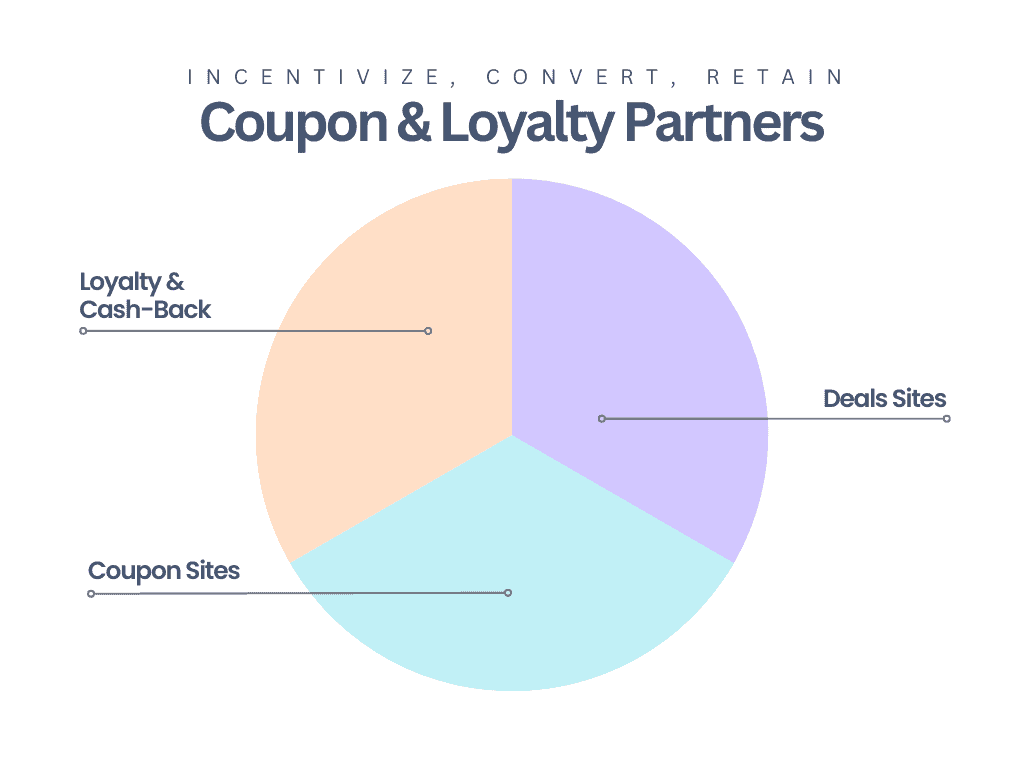
Coupon Sites
Coupon sites drive traffic through exclusive deals, promotions, and discounts, incentivizing purchases for cost-conscious consumers.
Coupon sites have a massive audience and are top conversion drivers for brands looking to boost traffic and revenue.
Top coupon sites such as RetailMeNot, Honey by Paypal, and Coupon Cabin are always looking for the best commissions and programs that convert well. Make sure you can offer them great deals if you want to drive more traffic.
Advertisers don’t need to always have aggressive discounts or coupons to work with these partners though. If you have every day offers such as free shipping or gift with purchase, or even offer new subscribers a welcome discount, you can work with coupon sites to promote these offers.
Coupon sites also offer opportunities for placement and more exposure such as in special deal pages, newsletters, or category pages. Be ready to increase your commissions and pay additional flat fees to get coverage though.
If you also want to make sure your listings get visible when coupon sites’ users search for a keyword, make sure to provide a list of relevant keywords you would like your brand to appear when a customer uses their search bar.
Building relationships with coupon sites also helps advertisers better control coupon and promo code usage and prevent abuse or the use of experienced ones.
Coupon site owners can help you make sure to turn off UGC and promo codes not allowed for use in deals and coupon sites.
Deal Sites
Deal sites promote special offers, creating urgency and driving conversions for ecommerce brands with time-sensitive discounts.
Deal sites such as Slickdeals, Brad’s Deals, or Dealmoon are very similar to coupon sites and sometimes the same publishers offer both coupons and deals.
If an advertiser does regular new product or category drops and offers bundles and deals on a regular basis to move stagnant inventory, deal sites are great partners to work with as they have a very loyal base of customers.
Similarly to coupon sites, deal sites have conversion facilitators and can help brands build traffic and revenue, especially during key seasons or events where they can incentivize and optimize their partnerships with these sites offering better deals and boosted commission payouts.
Is Your Affiliate Program Fully Optimized For Growth?
Take Our 2-Minute Quiz to Find Your Score!
Whether you are getting started with affiliate marketing or are responsible for scaling a mature program, there is always a new opportunity to unlock profitable growth.
Loyalty & Rewards Sites
Loyalty and reward sites encourage repeat purchases by offering incentives and enhancing customer retention and brand loyalty.
Loyalty and Rewards sites such as Rakuten, Top Cashback, or Be Frugal are great for advertisers and brands who keep premium pricing and don’t offer too many discounts but offer cash back or point-based incentives to customers on a budget.
Loyalty sites are great for helping drive new-to-file customers. But, if you plan to list your brand or ecommerce on cashback websites or apps, first study the audience and ensure it is different from your visitors. Otherwise, people who already order from you will order through the affiliate program.
There are setup and integration fees usually required to get advertisers and brands set in loyalty sites and in order to get à dedicated merchant page with all your deals hosted in the sites for shoppers to discover.
The commission structure is usually a revenue share model where the publisher splits the commission earned with their customers.
For example, if a brand works with a loyalty site offering to pay 10% cash-back, this means that the publishers with – in most cases – offer 5% cash back to their customers and keep 5% commissions.
Affiliate managers should be running a cash-back analysis to spot competitors’ rates during key seasons can help stay on the course during the holiday as loyalty sites will usually require higher cash-back boosts to give back to their customers.
Cross-Method Partners
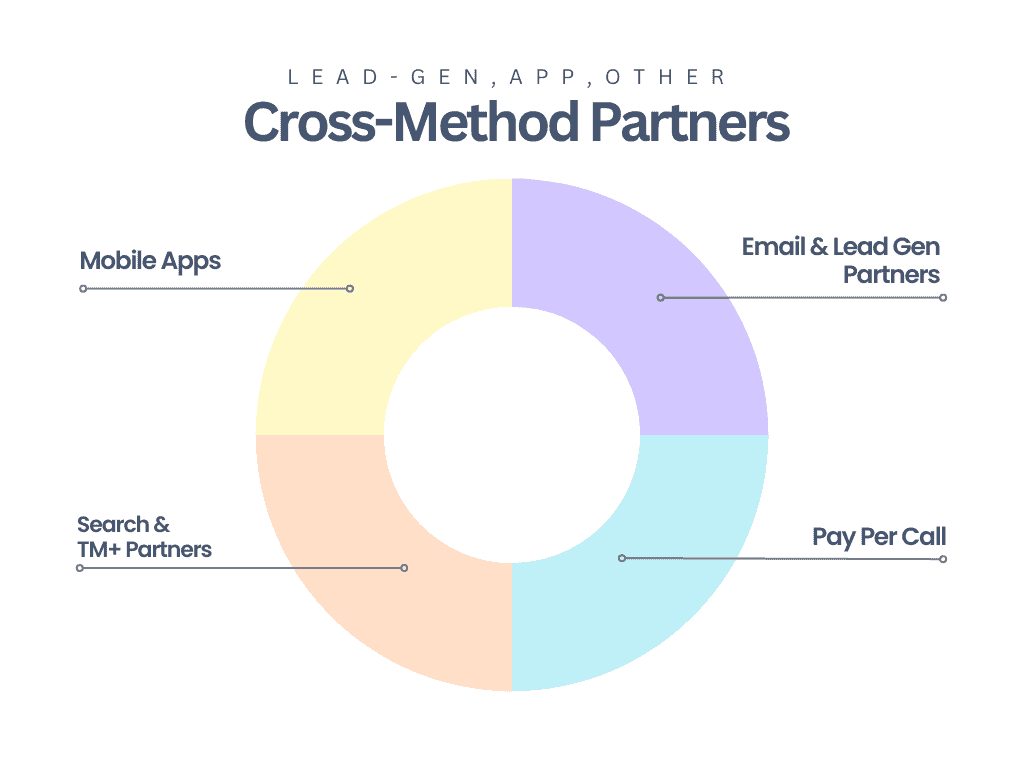
Email and lead generation
Email and lead generation partners are organizations that businesses collaborate with to help acquire and nurture potential customers or “leads” through email marketing and other digital strategies. These partners play a crucial role in building and expanding a company’s customer base and increasing its revenue.
Working with email and lead gen partners can help brands acquire new customers and leads but with many privacy and restrictions with email marketing and data privacy, brands need to ensure that negotiated email lists with these partners are CAN-SPAM compliant lists; otherwise, you will put your brand in danger.
We recommend working with lead-based email publishers to generate prospective consumer interest or inquiries as a first touch with a new audience.
Loyalty, deals, coupons, and content sites are also publishers that produce a content-rich email distributed to their owned or shared database of customers. This is a great way to work on newsletter placement deals with these partners during key holiday seasons to diversify your visibility on these sites through various media formats.
Email Retargeting also generates a personalized experience for customers who have exited the advertiser’s site during the checkout process. The email will only make reference to the products that were abandoned.
Mobile Apps
Mobile apps offer convenience for customers to browse and shop, providing a seamless shopping experience and encouraging repeat usage.
Affiliate marketing through mobile apps can help merchants reach a wider audience. Mobile apps often have specific niches or target demographics.
This allows merchants to have their products or services promoted to a highly targeted and relevant audience, increasing the likelihood of conversion.
With the rise of mobile app partnerships come the rise of geofencing and geo-based targeting capabilities for brands to help drive in-store traffic and conversions.
Is Your Affiliate Program Fully Optimized For Growth?
Take Our 2-Minute Quiz to Find Your Score!
Whether you are getting started with affiliate marketing or are responsible for scaling a mature program, there is always a new opportunity to unlock profitable growth.
Search Partners (Trademark Plus bidders, PPC networks)
Search partners are partners who promote brands and advertisers using PPC trademark bidding tactics.
Advertisers can work on a CPC payout model with a partner and pay for referred clicks or they can grant trademark plus rights (TM+ rights) to bid on the brands’ terms to target potential customers searching for a specific brand.
Brands can pay these Trademark Plus partners on a CPA basis – for example on any referred sales coming from a Trademark Plus campaign.
Working with these partners can help increase your footprint and presence on Search Results and can be useful to combat the competition.
It’s essential to strike a balance between reaching a wider audience through search partners and protecting your brand from trademark violations while also leveraging PPC affiliates to increase your online visibility and sales.
Financial and Tech Partners
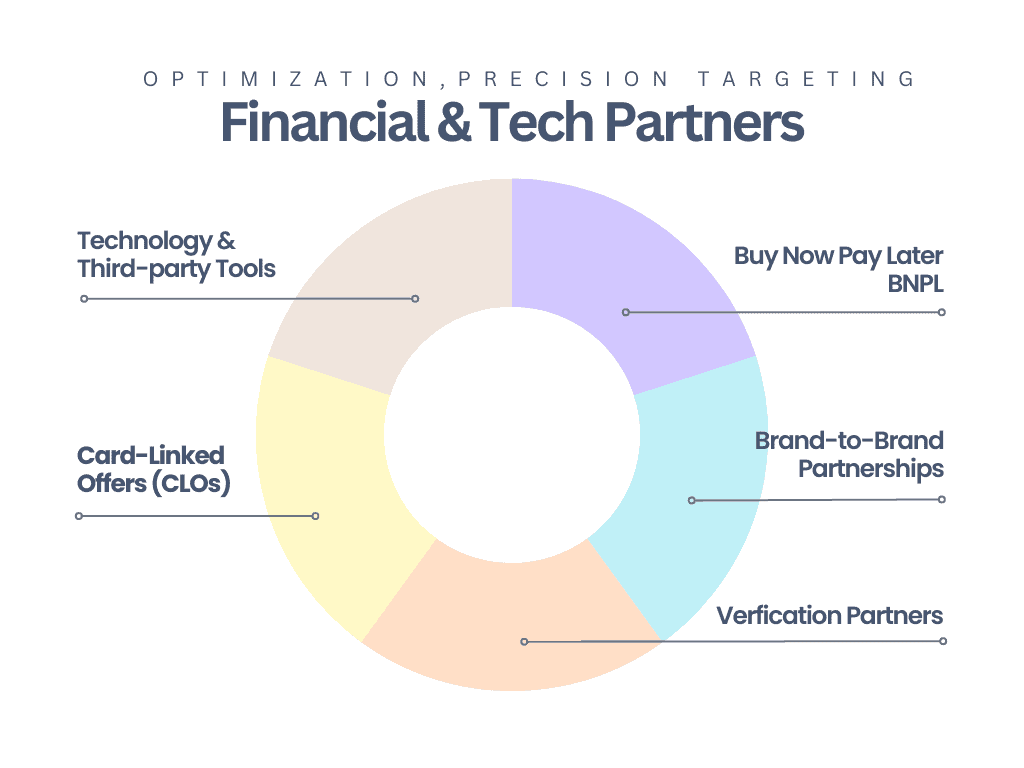
Technology & Third-Party Tools
Technology partners – such as Upsellit, RevLifter, or Cartera – are a group of affiliates who focus on conversion optimization solutions for the advertiser site.
They can create digital campaigns to address specific pain points in your customer’s journey – from on-site conversion, to email capture, cart abandonment and cross-device tracking, and AI recommendations
These partners usually require integration and setup fees but are an excellent partnership to leverage to put powerful ecommerce targeting tactics in place to help brands boost their sales.
These partners can work on a 100% revenue-share model and help brands acquire new customers in a cost-effective way by recovering lost sales.
Card-Linked Offers (CLOs)
Card-link offer sites facilitate easy cashback and rewards programs, incentivizing purchases and increasing customer loyalty.
Card-link offers require customers to link their credit cards with an app or website and allow them to capitalize on points and rewards shopping offline.
CLOs are more complex partnerships to implement but advertisers working with CLOs can gain market share, acquire new customers, increase loyalty, or drive omnichannel sales very quickly.
You can create a massive scale for your program with precision targeting campaigns of people who have not recently purchased or re-engaged lapsed customers or target new customers.
Credit cards are the partners who can receive the commissions for driving these transactions and advertisers can work with platforms, agencies, or intermediaries such as Figg or Cardlytics to help facilitate the partnership.
Learn more about how to capitalize card-linked offers and win your affiliate strategies.
Verification Partners
Verification partners are sites or solutions that allow advertisers to identify and verify specific persons in a specific subgroup such as military, medical, students, etc.
Advertisers and brands can work with verification partners such as ID.me or Student Beans to acquire new customers or retain their most loyal base.
There are two ways to partner with verification partners;
- by implementing verification processes directly into your ecommerce or merchant’s site
- By promoting offers on verification partner sites’ marketplaces such as StudentBeans where students are signed up to and verified, so they’ll get access to all advertisers and retailers offering discounts within the platform.
Similarly to coupon sites, deal sites, or traditional affiliate sites, advertisers pay on successful verification most of the time and sometimes on a CPA basis.
Buy Now Pay Later (BNPL)
Buy now pay later sites enable flexible payment options, reducing purchase barriers and increasing average order values for ecommerce brands.
BNPL partners such as Klarna, Affirm, or Afterpay allow consumers and shoppers to split payments at a merchant over a period of time.
Many ecommerce and merchants’ sites started to implement BNPL solutions as an option to combat inflationist rates and still allow shoppers to access their favorite brands paying the bills in several installments.
BNPLs have a huge audience to tap into to help target new-to-file customers with higher AOV and CVR potential and incrementality.
While BNPLs are Integrated partners on merchants’ sites and may require onboarding fees and higher CPA than more traditional affiliate partners, it can be an excellent partnership to leverage, especially during end-of-year holidays and shopping seasons.
Offering boosted commissions can help advertisers unlock additional featured placement exposure in BNPLs’ marketplaces.
Strategic Brand-to-Brand Partnerships (B2B)
Brand-to-brand partnerships amplify brand exposure and allow mutual promotion, reaching wider audiences and driving sales – usually between two merchants or advertisers.
While B2B partnerships are a bit complex to implement and may require dedicated teams to plan for and develop, these partnerships can drive growth, especially for brands in similar industries.
For example, a brand selling supplements, vitamins, or probiotics can build partnerships with a sports apparel retailer to co-sponsor a running event for example.
The vitamin brand can get some placements in the newsletter from the sports apparel retailer, getting to reach new audiences and vice versa; the sports brand can promote products and sponsored content on the vitamin merchant’s website, getting to drive traffic and referred sales.
The partnership can be monetized using performance-based payouts such as commission per sale or cost per new user signups, or require flat fees for some placement or sponsored content deals.
When well-executed, both brands can yield incremental results without the risk of sales cannibalization.
Sub-Affiliate Networks
Sub-affiliate networks or sub-networks house thousands of websites and influencers and provide technology that allows publishers to easily monetize their content with affiliate links.
Working with a sub-affiliate partner casts a larger net of potential partnerships to help scale your program quickly and cost-effectively. Because sub-affiliate partners maintain a large network of partners – including top content and media publications – they can drive a significant amount of traffic and revenue.
Sub-networks are set up in larger networks such as Impact, CJ, or ShareaSale, and syndicate links and offers to their own affiliates while sharing a portion of the commission.
Sub-affiliate networks work with both advertisers and affiliates. Brands connect with them to access the sub-networks affiliates. In exchange for this, the sub-affiliate network takes a percentage of the commission for themselves and hands the rest off to their affiliates.
These partnerships can be a great way to increase merchants’ sales, and there are many great sub-affiliate networks that have a good reputation such as Skimlinks, Sovrn, or LTK.
However, it is something to think about – sometimes affiliates that you wouldn’t normally get approved in larger networks can use these networks to promote advertisers’ brands and make money. Sometimes sub-networks are not transparent about who is promoting the brand.
Merchants should be ready to offer on average 10-30% CPA in these networks.
As we mentioned earlier, affiliate partners that are associated with sub-affiliate partners often include large publications such as Conde Nast, Hearst, and Dot Dash Meredith, amongst others.
When choosing to partner with a sub-affiliate network, do thorough due diligence to fully understand who you will be partnering with, and if the reputation of the network leaves no ground for doubt, ensure that the marketing approach proposed by the network is going to work for your business model.
Software, Toolbars, Browser Extensions
In affiliate marketing, browser extensions, and toolbars can be valuable tools to enhance your promotional efforts and drive more affiliate sales.
Publishers such as Rakuten, Honey, or BeFrugal will display advertisers’ products and offer consumers to set up plugins, browser extensions, and toolbars that will help them streamline their online discovery and purchasing experience.
Toolbars and browser extensions usually display the best coupons, deals, offers or cash-back consumers can get shopping on their sites.
Some loyalty sites incorporate a toolbar or browser button that alerts consumers if they are eligible to earn cash back on their purchases.
Whenever consumers are on a site where they can earn cash back, the browser button alerts them to the earning opportunity, and the consumer can click the browser button to set the loyalty site’s affiliate cookie, without ever leaving the retailer’s site.
Many see this as a disloyal practice, because toolbars and browsers’ extensions hijack the consumer midway through their shopping experience, forcing the retailer to pay commission when the loyalty site didn’t do anything to drive the traffic.
Toolbars and browser extensions; friends or foes? That still is in debate in the partnership space.
Publishers, retailers, networks, consumers, and agencies have different perspectives on that and make sure to analyze the potential impact, benefits, or disruptions in the purchase funnel they can have.
How to recruit the right partners for your affiliate program?
A balanced portfolio of affiliates ensures that advertisers are not overly reliant on one affiliate type or a single marketing channel. It helps spread the risk, reach various customer segments, and adapt to changing market conditions.
It’s essential to maintain a mix that aligns with your business goals and target audience. Regularly analyze the performance of each affiliate type and adjust your portfolio as needed to optimize results.
We recommend segmenting your partner based on the value of the partnership, rewarding higher CPAs for top-funnel partners such as content, review, and sub-affiliates such as influencers.
As you work with mid-to-lower funnel partners such as Loyalty, deals, coupons, and tech partners, you should start with low baseline commissions as they are usually high-conversion facilitator partners with lower incremental value than content partners driving new eyeballs and audience to your site.
Check out our article on how to recruit and manage high-performing affiliates to find ways to diversify your portfolio.
Is Your Affiliate Program Fully Optimized For Growth?
Take Our 2-Minute Quiz to Find Your Score!
Whether you are getting started with affiliate marketing or are responsible for scaling a mature program, there is always a new opportunity to unlock profitable growth.
Wrap-Up
Having a very diverse affiliate program with traditional partners such as content, loyalty, coupon, and deal sites should be the first step into building a diversified portfolio of partners driving value and growth for your ecommerce brand.
Other partners such as CSE affiliates, tech partners, CLOs, or strategic B2B partnerships are essential to consider to continue to develop a profitable program. is important. Remember that there are different payout models to consider so being flexible and open to negotiate early on is the key to successful and mutually-beneficial partnerships.
Success starts with The Good Strategy!






